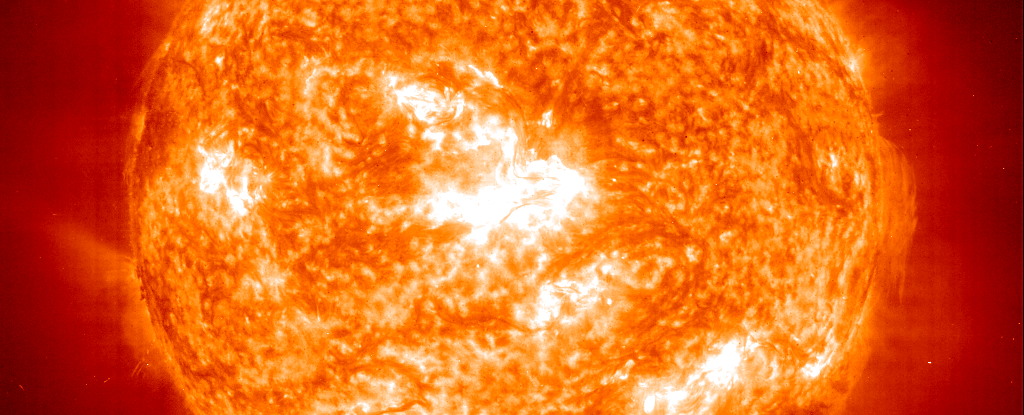One day, our Sun will die.
Since we happen to be inhabitants of the Sun's planetary system, the question of when, and how, this will happen, is of intense interest to us.
Sure, we're unlikely to be around to see it… but, you know, it's our home. We want to know what will eventually become of it. Mere curiosity aside, models of stellar evolution can help us understand the cosmos and our own place in it.
"If we don't understand our own Sun – and there are many things we don't know about it – how can we expect to understand all of the other stars that make up our wonderful galaxy," said astronomer Orlagh Creevey of the Observatory de la Côte d'Azur in France.
We already know in some detail what will happen in our Sun's future. It will continue to grow hotter over the next few billion years, eventually running out of hydrogen to fuse in its core.
The core will start to contract, a process that brings more hydrogen into the region immediately around the core, forming a hydrogen shell. This hydrogen then starts to fuse, dumping helium into the core, in a process called shell burning.
During this, the outer atmosphere of the Sun will expand by a lot, maybe even as far as the orbit of Mars, turning it into a red giant. Eventually, it will run out of hydrogen and helium, eject all its outer material to form a planetary nebula, and the core will collapse down into a white dwarf, which could take trillions of years to cool completely.
But the timing of the end of the main sequence depends on the individual characteristics of each star. As far as our own Sun goes, the ballpark figure of when things will go south could always use more evidence.
The best way to find that is by searching the Milky Way for Sun-like stars at different stages of their lives, and then weaving them into a timeline that models our own star's past and future.
With the latest release of data from the European Space Agency's Gaia Milky Way mapping project, we now have the most detailed timeline of the Sun's life yet.
Gaia's primary mission is to map the Milky Way with the highest precision yet, and it's equipped with a suite of instruments for that task. It tracks the positions and motions of stars in the sky, while taking detailed observations of each star's brightness and spectral classification.
These values can be used to determine factors like chemical composition and temperature. They can also be plotted on a graph known as a Hertzsprung-Russell diagram, which gives an estimate of the star's age.
A star's mass, you see, doesn't really change as it ages; but its temperature does, quite significantly, based on the nuclear fusion taking place in the stellar core, which is observed as changes in brightness.
Our Sun is classified as a G-type main sequence star, or yellow dwarf (even though it's not actually yellow), and is a fairly typical example of its kind.
It's about 4.57 billion years old, or about halfway through its main sequence lifespan. It's also capable of core thermonuclear fusion, generating a surface temperature of 5,772 Kelvin. This means that looking at other G-type stars should give us a pretty good idea of how our Sun might continue to burn fuel, and when it might eventually fizzle out.
Creevey and her team initially started combing the Gaia data because they wanted precision observations of stars with relatively 'cooler' temperatures between 3,000 and 10,000 Kelvin. That's because low temperature stars tend to be smaller, and live longer than the hotter ones; looking at cooler stars, therefore, can potentially reveal more about the history and stellar evolution of the Milky Way and the wider Universe.
Because this temperature range includes stars like the Sun, the data could be used to zero in on stars with a similar mass and chemical composition as the Sun. This resulted in 5,863 Sun-like stars across the entire Hertzsprung-Russell diagram, from very young to very old.
By identifying only the most Sun-like stars, Creevey and her colleagues were able to confirm the timing of its demise.
Broadly consistent with previous projections of the Sun's lifespan, its temperature will peak at around 8 billion years of age. It will transform into a red giant star at around 10 billion to 11 billion years of age.
Life on Earth, for the record, only has about a billion years left, unless we do something catastrophically stupid, or something catastrophic happens to us. That's because the Sun is increasing in brightness by about 10 percent every billion years; which means it is also increasing in temperature. That change sounds small, but it will render Earth uninhabitable to life as we know it.
So that's cheery. But there's still work to do. The new Gaia catalog of Sun-like stars could tell us more about how and why we are even here to start with. We can learn if Sun-like stars all behave the same way, for instance. And, more importantly, look for more planetary systems that look like the Solar System.
At the moment, we've not found any system that seems capable of harboring technologically advanced life as we know it. But the answers are out there. If we can find them.
